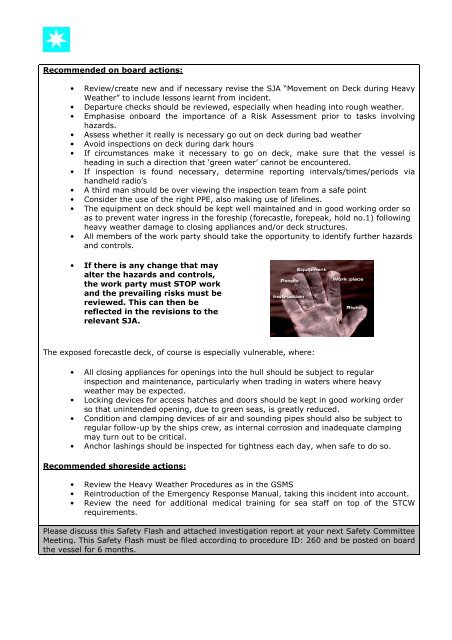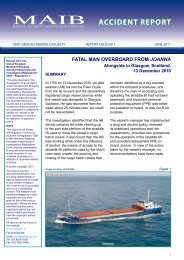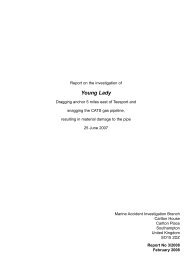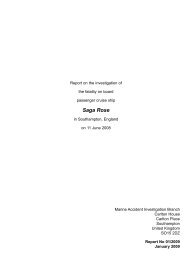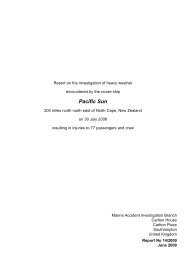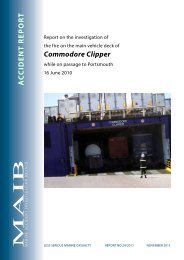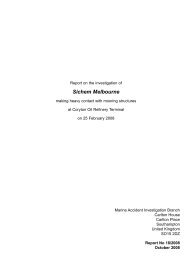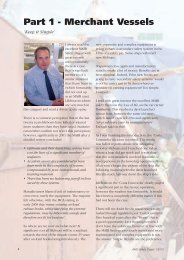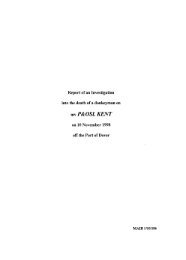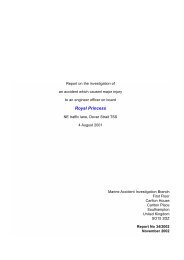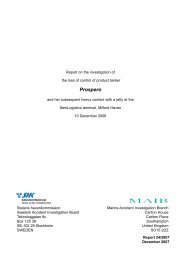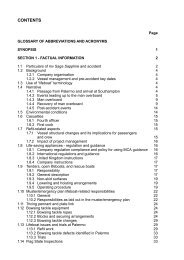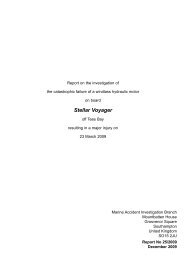Annex A Maersk checklist - Heavy Weather
Annex A Maersk checklist - Heavy Weather
Annex A Maersk checklist - Heavy Weather
Create successful ePaper yourself
Turn your PDF publications into a flip-book with our unique Google optimized e-Paper software.
Recommended on board actions:<br />
• Review/create new and if necessary revise the SJA “Movement on Deck during <strong>Heavy</strong><br />
<strong>Weather</strong>” to include lessons learnt from incident.<br />
• Departure checks should be reviewed, especially when heading into rough weather.<br />
• Emphasise onboard the importance of a Risk Assessment prior to tasks involving<br />
hazards.<br />
• Assess whether it really is necessary go out on deck during bad weather<br />
• Avoid inspections on deck during dark hours<br />
• If circumstances make it necessary to go on deck, make sure that the vessel is<br />
heading in such a direction that ‘green water’ cannot be encountered.<br />
• If inspection is found necessary, determine reporting intervals/times/periods via<br />
handheld radio’s<br />
• A third man should be over viewing the inspection team from a safe point<br />
• Consider the use of the right PPE, also making use of lifelines.<br />
• The equipment on deck should be kept well maintained and in good working order so<br />
as to prevent water ingress in the foreship (forecastle, forepeak, hold no.1) following<br />
heavy weather damage to closing appliances and/or deck structures.<br />
• All members of the work party should take the opportunity to identify further hazards<br />
and controls.<br />
• If there is any change that may<br />
alter the hazards and controls,<br />
the work party must STOP work<br />
and the prevailing risks must be<br />
reviewed. This can then be<br />
reflected in the revisions to the<br />
relevant SJA.<br />
The exposed forecastle deck, of course is especially vulnerable, where:<br />
• All closing appliances for openings into the hull should be subject to regular<br />
inspection and maintenance, particularly when trading in waters where heavy<br />
weather may be expected.<br />
• Locking devices for access hatches and doors should be kept in good working order<br />
so that unintended opening, due to green seas, is greatly reduced.<br />
• Condition and clamping devices of air and sounding pipes should also be subject to<br />
regular follow-up by the ships crew, as internal corrosion and inadequate clamping<br />
may turn out to be critical.<br />
• Anchor lashings should be inspected for tightness each day, when safe to do so.<br />
Recommended shoreside actions:<br />
• Review the <strong>Heavy</strong> <strong>Weather</strong> Procedures as in the GSMS<br />
• Reintroduction of the Emergency Response Manual, taking this incident into account.<br />
• Review the need for additional medical training for sea staff on top of the STCW<br />
requirements.<br />
Please discuss this Safety Flash and attached investigation report at your next Safety Committee<br />
Meeting. This Safety Flash must be filed according to procedure ID: 260 and be posted on board<br />
the vessel for 6 months.


